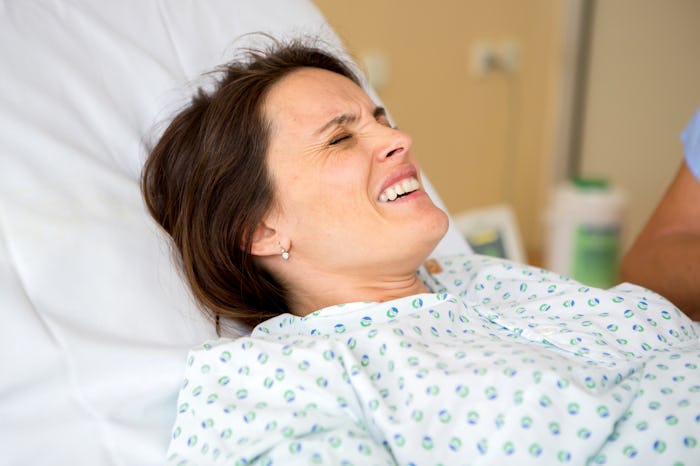Life

Um, Apparently You Get A Massage After Giving Birth — But It's Not What You Think
Massages are my favorite thing in the world. Whether its a foot rub or back massage, the healing and relaxation massages provide are incomparable. But if you are pregnant, you may have been reading about uterine massages, also known as fundal massages. This type of massage may not be the relaxing massage you are used to, but it may be necessary after your delivery. So what is a uterine massage exactly, and why would you need one?
In an interview with Romper, Dr. Mary O’Toole, an OB-GYN with MemorialCare Saddleback Medical Center in Laguna Hills, California, says that uterine massages are used to “tighten up” the uterus after delivery in order to expel blood and clots. “It is done after normal delivery and C-section to reduce the risk for hemorrhage," says O’Toole. Which means they may not exactly feel so great. (Ask your friends, they'll tell you.)
OB-GYN Dr. Amy Peters, of Saddleback Medical Center in Laguna Hills, California agrees, telling Romper that a uterine “massage” is really a euphemism, and is routinely performed postpartum to encourage the uterus to stay firm and reduce blood loss. “It involves pushing firmly on the uterus,” explains Peters, “and rubbing it to stimulate contractions.”
According to the American Academy of Family Physicians (AAFP), uterine massage plays an effective part in managing and preventing postpartum hemorrhage. This type of hemorrhaging can happen when your uterus fails to contract effectively after delivery, explained Baby Center, which can be caused by a number of factors including the delivery of multiples, delivering a very large baby, fibroids, infection, previous pregnancy hemorrhaging, severe preeclampsia, or trauma to the uterus.
Postpartum hemorrhaging is not very common, occurring in 5 percent of pregnancies, and symptoms are usually present within the first day of delivery, although some women can experience hemorrhaging up to 12 weeks after childbirth, explained the March of Dimes. The most obvious symptom, the website noted, is heavy vaginal bleeding, that does not stop or slow down, and can be accompanied by blurry vision, chills, weakness, dizziness, clammy hands, nausea, pale skin, and swelling and pain in or around your vagina.
The AAFP explained that after delivery, to prevent hemorrhaging, uterine massage is performed when the doctor or nurse places one hand on your abdomen and one hand inside your vagina, then gently compresses the fundus (the top portion of your uterus) from above your abdomen. This compression allows for blood and clots to be expelled from your uterus.
If you have consistent heavy bleeding after delivery, Baby Center noted that along with uterine massaging, your doctor may give you additional medications, like intravenous oxytocin, and they may also insert a catheter to empty your bladder (a full bladder can make it more difficult for your uterus to contract on its own). You doctor may also do a pelvic exam, the website explained, to see if there is any placenta left in your uterus and to see if there are any lacerations to your uterus that need to be stitched.
Luckily, postpartum hemorrhaging is rare, and uterine massages are used more as a preventative measure to make sure your uterus is doing its job and getting rid of the excess blood and clots. If you are pregnant, and have questions about uterine massaging after delivery, talk to your physician or healthcare team and voice your concerns.
Hopefully, after you have recovered from childbirth, you can head out to get a real massage, because after what you and your body went through, you deserve to relax and feel good.
Check out Romper's new video series, Romper's Doula Diaries:
Watch full episodes of Romper's Doula Diaries on Facebook Watch.